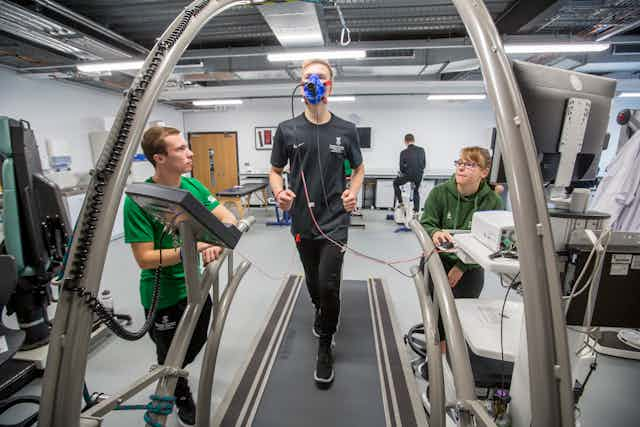If you could pick one measure to evaluate your health, what would you pick? Blood pressure? Cholesterol? These are commonly measured by your GP, but there is something that is more informative: maximal aerobic capacity, otherwise known as VO₂max.
This measure tells you your maximum (max) rate (V) of oxygen (O₂) uptake and use during exercise. The greater this is, the better your health. In fact, VO₂max is the best predictor of your risk, at a given point in time, of getting chronic diseases like heart disease, type 2 diabetes or certain cancers, and the best predictor of your chances of living a long and healthy life. Intuitively, this does not make much sense: most people go through life without ever needing to reach their VO₂max.
If you thought VO₂max was just for athletes, you’d be partly right. VO₂max is also used as a performance measure for endurance athletes. This makes sense as endurance athletes need to have a good ability to take up and use oxygen to generate the energy to perform exercise.
Athletes with a higher VO₂max can generate more energy, work at a higher intensity, and perform better than athletes with a lower VO₂max. But, although VO₂max is often used in athletes and rarely for routine health checks, the use of VO₂max as a predictor of performance is actually much weaker than its use as a predictor of health.
VO₂max measurement
The physiologist and Nobel laureate, Archibald Hill, in 1923, was the first to measure and describe the concept of VO₂max after he noticed that the body’s oxygen requirements (quite low when resting) increase in proportion to increased running speed. He went on to describe how the actual rate of oxygen used by the body eventually reaches a maximum level, even when running speed is increased further (that is, it has reached a plateau). VO₂max occurred at different running speeds in different individuals and exhaustion closely followed.

The tests for measuring VO₂max are similar today. Participants start exercising at a low intensity, after which the intensity increases slowly until the participant cannot go any further because of exhaustion (many readers will be familiar with the format of the dreaded bleep test, which is similar).
During the test, participants breathe through a tube connected to an oxygen analyser to measure the rate of oxygen usage (VO₂). The highest value achieved is termed VO₂max. It is usually expressed in millilitres of oxygen per kilogram of body mass per minute (ml/kg/min), to remove the confounding effect of body size. Although, it is important to note that this method of accounting for body size is an estimate at best and can often be very misleading.
A good or a bad measure of performance?
There is a wide variation in VO₂max between people, mainly explained by genetics and exercise history. Elite endurance athletes can have VO₂max values about three times higher than inactive people (90ml/kg/min vs 30ml/kg/min). The highest documented VO₂max is 97.5ml/kg/min in an elite cyclist. The correlation between VO₂max and exercise performance is good when you look at people with a wide range of VO₂max values.
Conversely, VO₂max is a poor predictor of performance when you only consider athletes of similar ability. Also, after a period of training, the change in VO₂max is not at all related to changes in exercise performance. This means that VO₂max is, in fact, a poor measure of performance in circumstances where it is commonly used.
VO₂max is, of course, an important contributor to performance because it sets the theoretical upper limit for prolonged endurance exercise. This is not a practical upper limit, however. Even the most elite endurance athletes can only exercise at their VO₂max for a few minutes. To complete a fast marathon or bike race, you do need a high VO₂max, but, more importantly, you should be able to sustain a high percentage of your VO₂max for extended periods of time.
VO₂max and health
Many studies have demonstrated that the risk of cardiovascular disease and early death is much lower in people with high VO₂max compared with people with low VO₂max. People who manage to improve their VO₂max over time will lower their risk of disease and live longer. Contrary to expectation, though, this does not seem to be the case for people who manage to lose weight over time.
The logical question to ask is why VO₂max is so important for long-term health. This question has largely been ignored by researchers, and there are no clear answers. In our research, our working hypothesis is that VO₂max is a proxy for the amount of blood in the body. A greater volume of blood allows more oxygen to be transported to the muscles and so leads to a higher VO₂max.
Having enough blood is beneficial to the whole body. Think about the ability to divert blood to your skin to cool down when it is hot while at the same time sending enough blood to the stomach and intestines to digest your ice cream. Or the ability to recover from a big operation that inevitably is associated with blood loss. The reason we know that VO₂max is a good predictor of health, while we don’t have much information about the importance of the total amount of blood in the body, is because blood volume is very difficult to measure (draining someone’s blood is frowned upon).
To improve your VO₂max, the only feasible and legal way is regular exercise, with high-intensity interval training being more effective than continuous moderate intensity training. Recent studies have also demonstrated that robust improvements in VO₂max can be achieved with very low volumes of intense exercise.
VO₂max may not always be the best measure of exercise performance, but it is undoubtedly important for our health, and we should all maintain exercise routines and work hard to improve it.

